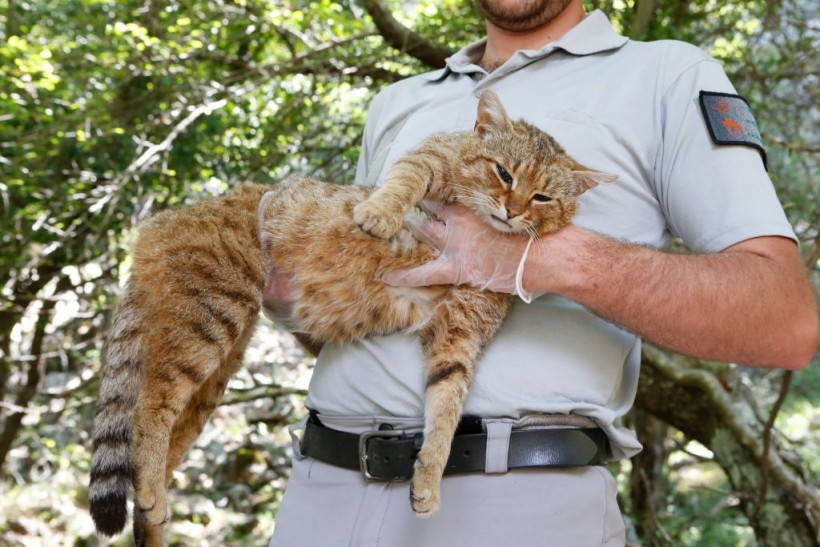Local shepherds on Corsica, a Mediterranean island, have passed down stories of the "ghjattu volpe" attacking sheep and goats for generations. Initially documented in 1929, new genetic research suggests that this elusive wildcat may be a previously unidentified species.
It is only this year that the cat-fox is recognized as a new species and the National Hunting and Wildlife Office (ONCFS) of France hopes its classification will aid in species protection and awareness efforts.

An employee of the French Forest and Hunting Office (Office Nationale des Forets et de la Chasse) Charles-Antoine Cecchini holds a "ghjattu-volpe" (fox-cat) Felis Silvestris on June 12, 2019 in Asco on the French Mediterranean island of Corsica.
Mythical Wildcat of Corsica
The moniker "cat-fox" for Corsican wildcats is derived from their fox-like coloration and distinctive large tail. Despite the suggestive name, these creatures are unequivocally part of the cat family, belonging to the genus Felis alongside other wildcats and domestic cats. Researchers are delving into the genetics of Corsican wildcats to precisely determine their placement within this group.
Distinguishing features of Corsican wildcats include fewer stripes compared to European and Sardinian counterparts, prompting ongoing investigations into the extent of their differences.
To be officially designated a new subspecies, comparisons with Near-Eastern mainland wildcats are imperative, though the intricate process is complicated by various wildcat lineages across Europe, Asia, and Africa. Additionally, the interbreeding of domestic cats further complicates the categorization.
Exclusive to a small region within the Asco forest in Corsica, the cat-fox's appearance may resemble a domestic pet, but its unique characteristics, such as a long, ringed tail with a black tip, set it apart. Introduced to Corsica around 8,000 years ago during the Neolithic era, likely for pest control purposes, the cat-fox remained largely unseen until 2008.
The first thorough analyses of these elusive creatures were conducted in 2016 by the ONCFS, shedding light on their mysterious behavior, diet, and population size. Further research may unveil the long-awaited revelations about Corsica's enigmatic ghjattu-volpe after decades of speculation.
READ ALSO: How Different is the Canada Lynx Wildcat From Other Species of Its Kind?
Cat-Fox a New Subspecies of Felis Species
Disputing certain media claims, Corsican wildcats are not an entirely novel species. A study, titled "Population genomics of Corsican wildcats: Paving the way toward a new subspecies within the Felis silvestris spp. complex?" published in Molecular Ecology on January 19 this year, suggests that Corsican wildcats may represent a subspecies or a distinct group within established Felis species.
On March 16, the OFB affirmed the distinctiveness of the ghjattu volpe as a unique cat species in Corsica, following a genetic study comparing the genetic profiles of wildcats on the French island with those in metropolitan France and domestic cats.
Researchers examined genetic samples from Corsican wildcats and domestic cats, contrasting them with counterparts from Sardinia and mainland Europe. The findings unveiled the unique nature of Corsican wildcats, setting them apart from European wildcats, domestic cats, and, to a lesser extent, Sardinian wildcats.
While traditional classification placed wildcats under the species Felis silvestris, with European wildcats falling under the subspecies F. s. silvestris and Afro-Asiatic wildcats under F. s. lybica, the International Union for Conservation of Nature now recognizes Afro-Asiatic wildcats as a distinct species (F. lybica). Understanding the significance of the lybica lineage is pivotal in comprehending domestic cats and the recent revelations about Corsican wildcats.
The lybica species is considered the progenitor of domestic cats that may have been introduced to Corsica and Sardinia around 8,000 years ago, remaining wild since the early stages of domestication.
RELATED ARTICLE: How Did Domestication of Cats Began in Central Europe? Scientists May Have the Answer
Check out more news and information in Animals Science Times.














